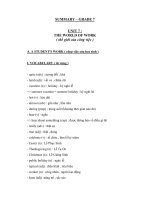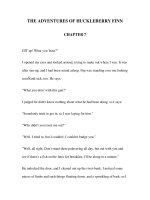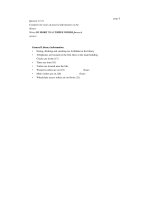Quick puntuation guide 7 ppt
Bạn đang xem bản rút gọn của tài liệu. Xem và tải ngay bản đầy đủ của tài liệu tại đây (63.56 KB, 6 trang )
Speaking Test Hints
CONCLUDING THE INTERVIEW
Requirements
When the examiner has finished the discussion in Part 3, the Speaking Sub-test has come to an end.
The examiner will thank you for talking and the interview is concluded.
• remember to thank the examiner for his or her time and say goodbye.
• as you leave the room, don't forget to remain positive - the examiner might not
have yet completely made up his or her mind about your score, and the final
impression you make is important.
If you have questions about the test itself, such as when the results will become
available, talk to the person in charge of the day's proceedings
What To Do and What Not To Do
1 Relax and remain in control right up until
the moment you leave the interview room.
2 Shake hands confidently, if you are invited
to do so, and thank the examiner for his or
her time.
3 Simply say:
"Thank you very much for your time. I
enjoyed talking with you. Goodbye."
or a similar concluding sentence or two
of your own.
1 Do not tell the examiner how relieved you
are the test is over, and there is no need to
comment on your performance!
2 Do not overdo your friendliness at the end.
Be glad you did your best, smile and leave
the room.
3 Do not ask the examiner for your Band
Score. He or she is unable to give you that
information.
AFINALJWORD^ ^
IELTS is a demanding and challenging examination. Because the Band Score you receive is
probably of great importance to your future you should a make a serious effort RIGHT NOW to
achieve the level of English you require. Don't wait until tomorrow - tomorrow never comes.
Think deeply about what you can achieve with your life if you score well. Think about what you
will be able to do later.
Well-placed effort is always rewarded. The hard work you do now will eventually make your life
easier. A little pain now for a lot of gain later. That is the secret of success - perhaps the secret of
living itself- for learning never ends.
The first time you take any test you are unfamiliar with the way in which it is conducted and will
naturally feel slightly nervous. Many candidates take the IELTS test the first time for practice - to
get an accurate assessment of their level and to familiarise themselves with the process - before
taking it a second or even third time. Each time you must wait for three months before being allowed
to take the test again. It takes at least that period of time to increase your overall Band Score by one
Band, and requires intensive daily study.
Good luck and remember the Golden Rule
83
The Practice Tests
PRACTICE TESTS
HOW TO TAKE THE PRACTICE TESTS
Before the Practice Tests
Find a quiet room with a desk, and make sure that you have enough time to complete each test
and are not going to be interrupted.
You will need a pen and two photocopies of the Listening and Reading Test Answer Sheet on
page 163, and a photocopy of the Writing Test Answer Sheets on pages 164 and 165. You will
also need a cassette player for the Practice Listening Tests, a blank tape for the Practice Speaking
Tests, and a watch or clock.
NB: The suggested times given in this book for the smaller blocks of Reading Test questions are not
a feature of the actual IELTS Reading Test. They are given to assist with your practice sessions only.
During the Practice Tests
Follow each test's instructions carefully, and do not spend longer on the examination than the
instructions allow. If you spend longer on the Practice Tests than the instructions allow, you will
not get an idea of how well you will perform in the real IELTS examination.
When you have finished the Listening Test, allow yourself 10 minutes to transfer your answers
onto the Answer Sheet, give yourself a short break, and then go on to the Reading Test.
At the beginning of each part of the Reading Test there are suggestions for how long you should
spend on each set of questions. Be sure to follow these suggestions carefully.
At the end of 60 minutes, stop doing the Reading Test and immediately continue with the Writing
Test. Then go on to the Speaking Test, and record your responses on a blank tape.
After the Practice Tests
Check your answers to the Listening and Reading Tests with the Answer Keys on pages 160 and
159. Check your answers to the Writing Tests with the Model Answers on pages 166 to 169. Ask
a teacher to look at your Writing Tasks and to listen to the tape you recorded for the Speaking
Test in order to estimate your scores.
Then use the Score Interpreter on page 162 to discover how well you did in each Sub-test, and
how much extra English study you may need to do to improve your score. In the actual IELTS
test, your Overall Band Score is the average of the 4 Sub-test Band Scores.
Once you have completed Practice Test One, and have checked with the Score Interpreter, turn
to the Hints Section for help with those questions that caused you difficulty. The guide to using
the 101 Helpful Hints is on page 11. Then continue the test process with Practice Tests Two,
Three and Four on pages 107, 127 and 138 respectively.
85
101 Helpful Hints for IELTS
Pre-Test:
1-5
During Test:
6-10
PRACTICE TEST ONE
PRACTICE LISTENING TEST ONE
This is a practice listening test that resembles the International English Language Testing System
Listening Test. The test consists of four sections. Answer the questions as you listen to the
recording. Note that the recording is played once only.
Section 1
Questions 1-4
8
16-17
Decide which picture is the best match with what you hear on the tape, and circle the letter under
that picture. The first one has been done for you as an example.
Example: How do George and Lisa get to the airport?
®
B
D
i8i9 Q1. What are they looking for?
20-21
B
c
D
86
c
A
Practice Test One
Q2. Who do they ask for directions? 18
B
1
C
D
Q3. Where is the FrancAir Check-In desk?
18
19-21-22
B
D
87
101 Helpful Hints for IELTS
18
Q4. What does George want to buy before he catches the plane?
B
D
8
16-17
23
Questions 5-13
Fill in the information you hear on the form below in the spaces numbered 5-13.
The first one has been done for you as an example.
15
20
10
14-15-19
59
1
14-22
59
1
15-19
19 -59
1
15-19
Check
11-15
PAID Excess Baggage Declaration Certificate
(5)
Given Name: (Example:)
Family Name: (6)
Nationality: (7)
Flight Number: (8)
Destination: (9)
Contact Number: (10)
Declaration of Contents:
11)
12)
13)
88
c
A
Practice Test One
Section 2
Questions 14 - 21
You will now hear a short news item. Fill in the gaps in the summary below with the correct word
or phrase according to what you hear. The first one has been done for you as an example.
6-10
23-25
16-17
The traffic accident in (Example) 9
has caused the death of (14) persons, and a 15-20
further (15) people have been taken to St. John's 15
(16) for treatment. The northbound
and southbound lanes of Avalon Road are still closed, and
drivers are advised to avoid the area.
Police believe the driver of a (17) , 12-19
21
lost control of the vehicle before reaching the traffic
(18) at the corner of Avalon Road and Batty 1219
65
s
Avenue. Witnesses told reporters that they heard the lorry sound
the (19) moments before it collided with traffic 1019
turning into the (20)
Anyone requiring further information should telephone the
police hotline on (21) 15-19
Check:
11-15
89









